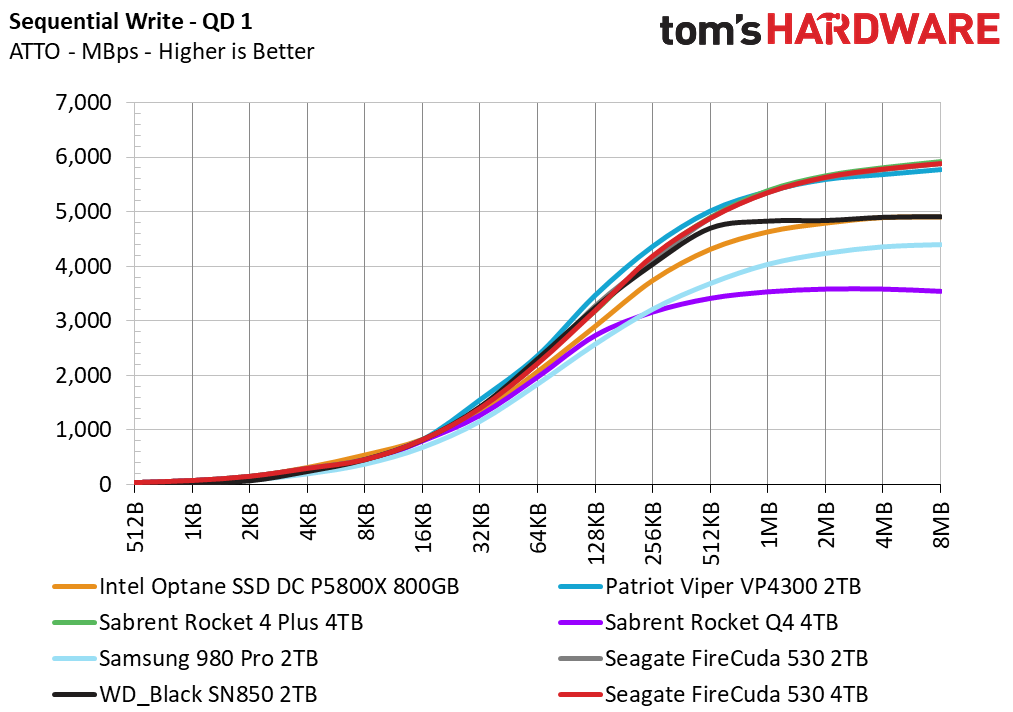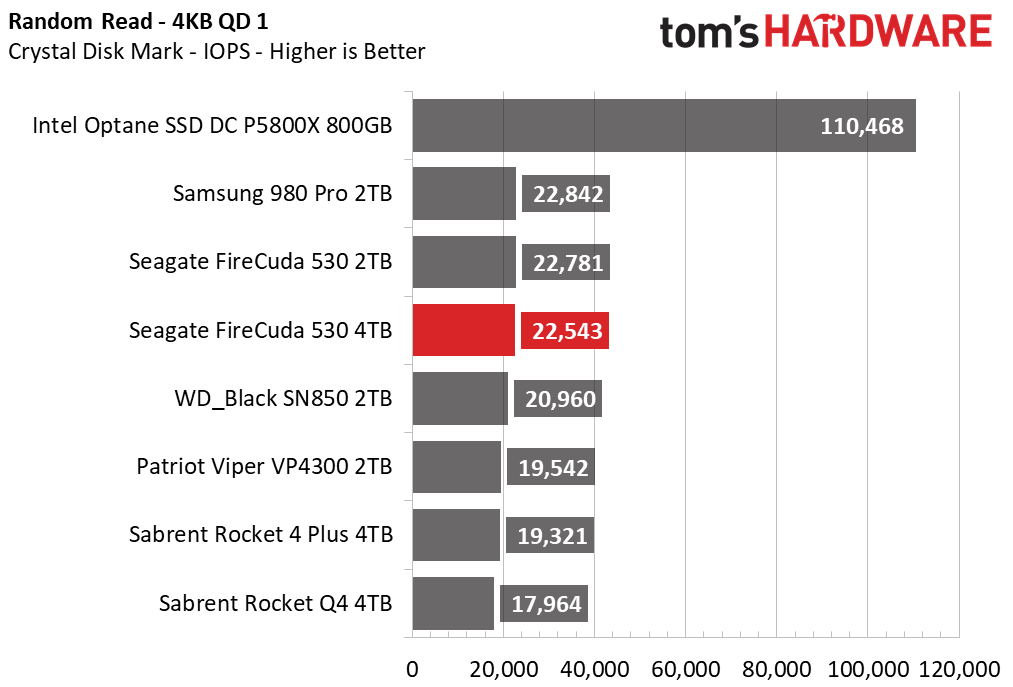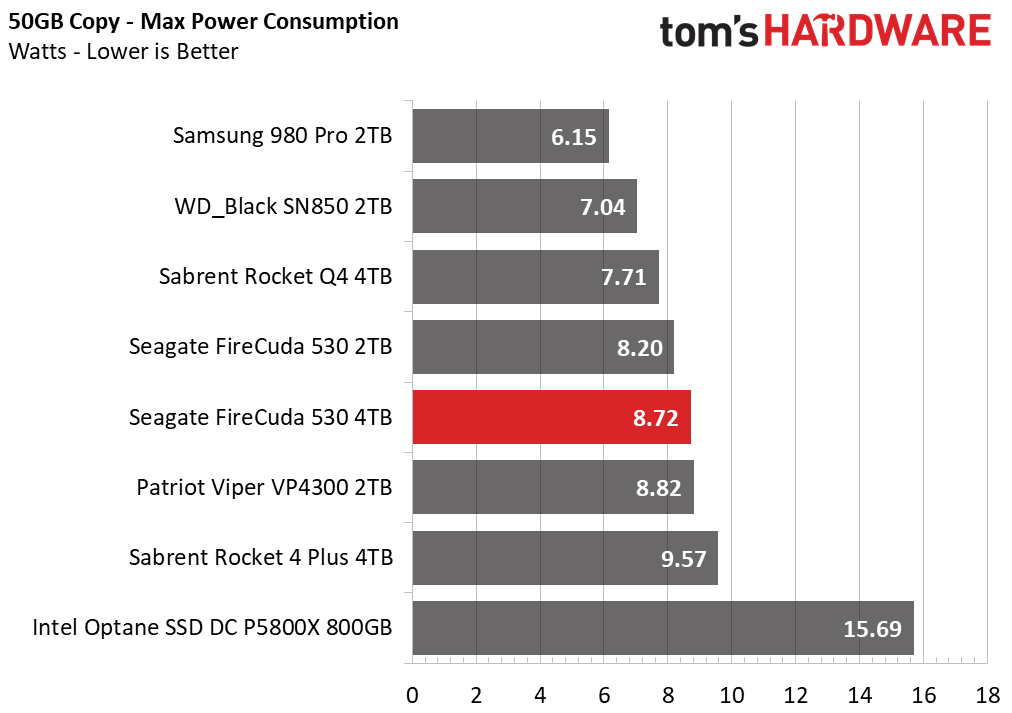Why you can trust Tom's Hardware
Comparison Products for Seagate FireCuda 530 4TB
Today, we put the 4TB Seagate FireCuda 530 against the Best SSDs in its class, including the Intel Optane DC P5800X, WD_Black SN850, Samsung 980 Pro, Sabrent Rocket 4 Plus, Patriot Viper VP4300, and of course, the 2TB FireCuda 530. We also threw in an entry-level Gen4 SSD, the Sabrent Rocket Q4, for good measure.
Game Scene Loading - Final Fantasy XIV
Final Fantasy XIV Shadowbringers is a free real-world game benchmark that easily and accurately compares game load times without the inaccuracy of using a stopwatch.
Second only to the Intel Optane powered DC P5800X, the Seagate FireCuda 530 ranks as one of the fastest NVMe SSDs we have tested. The 4TB model proved slightly faster than the 2TB FireCuda and even outperformed the WD_Black SN850, Sabrent Rocket 4 Plus, and the Samsung 980 Pro.
Transfer Rates – DiskBench
We use the DiskBench storage benchmarking tool to test file transfer performance with a custom dataset. We copy a 50GB dataset including 31,227 files of various types, like pictures, PDFs, and videos to a new folder and then follow-up with a reading test of a newly-written 6.5GB zip file.


The Seagate FireCuda took second place in the large file transfer test, but that was only to the large and power-hungry Intel Optane DC P5800X, which isn’t the best comparison product due to its eye-watering pricing.
The 4TB FireCuda fell behind the 2TB FireCuda 530 when we read the files back, but it was still faster than the WB_Black SN850, Samsung 980 Pro and Sabrent Rocket 4 Plus.
Trace Testing – PCMark 10 Storage Test
PCMark 10 is a trace-based benchmark that uses a wide-ranging set of real-world traces from popular applications and everyday tasks to measure the performance of storage devices. The quick benchmark is more relatable to those who use their PCs for leisure or basic office work, while the full benchmark relates more to power users.
Get Tom's Hardware's best news and in-depth reviews, straight to your inbox.






The WD_Black proves to be the fastest NVMe SSD in PCMark 10’s workloads, but the 4TB FireCuda 530 once again trails the 2TB variant and the expensive Optane DC P5800X in each test thrown its way. However, it outperforms the rest of the drives.
Synthetic Testing - ATTO / CrystalDiskMark
ATTO and CrystalDiskMark (CDM) are free and easy-to-use storage benchmarking tools that SSD vendors commonly use to assign performance specifications to their products. Both of these tools give us insight into how each device handles different file sizes.














Seagate’s 4TB FireCuda 530 notches some of the fastest sequential read and write speeds at a queue depth of one, but Intel’s Optane DC P5800X, which doesn’t have competitive pricing, was still faster with smaller blocks.
Seagate’s 4TB FireCuda 530 does well during the random read workload, matching the Samsung 980 Pro and responding faster than the WD_Black SN850 at a QD of 1. We dialed the workload up to a QD of 256, and the FireCuda 530 maxed out at roughly 825,000 / 1,555,000 random read/write IOPS.
Sustained Write Performance and Cache Recovery
Official write specifications are only part of the performance picture. Most SSDs implement a write cache, which is a fast area of (usually) pseudo-SLC programmed flash that absorbs incoming data. Sustained write speeds can suffer tremendously once the workload spills outside of the cache and into the "native" TLC or QLC flash. We use iometer to hammer the SSD with sequential writes for 15 minutes to measure both the size of the write cache and performance after the cache is saturated. We also monitor cache recovery via multiple idle rounds.





Per our measurements, the 4TB FireCuda 530 comes with a large 450GB SLC cache. The FireCuda wrote data at a rate of 6.9 GBps until the SLC cache filled, but then performance degraded to an average write rate of 4 GBps for an additional 3TB before the drive slowed down once again. In its slowest writing state, the FireCuda 530 wrote at 1,625 MBps until full.
While the FireCuda’s sustained write performance is monstrous, it recovers slowly. While some SSDs recover their SLC cache within our idle round testing spanning up to 30 minutes, the FireCuda 530 did not.
Power Consumption and Temperature
We use the Quarch HD Programmable Power Module to gain a deeper understanding of power characteristics. Idle power consumption is an important aspect to consider, especially if you're looking for a laptop upgrade. Some SSDs can consume watts of power at idle, while better-suited ones sip just milliwatts. Average workload power consumption and max consumption are two other aspects of power consumption, but performance-per-watt is more important. A drive might consume more power during any given workload, but accomplishing a task faster allows the drive to drop into an idle state more quickly, ultimately saving energy.
We also monitor the drive’s temperature via the S.M.A.R.T. data and an IR thermometer to see when (or if) thermal throttling kicks in and how it impacts performance. Bear in mind that results will vary based on the workload and ambient air temperature.




The 4TB FireCuda 530 doesn’t provide chart-topping efficiency, but it’s still very efficient nonetheless. The Samsung, WD_Black, and Patriot Viper stick out as more efficient options under load. However, at idle, the 4TB FireCuda takes second place. Notably, the FireCuda 530 proves more efficient than the Sabrent Rocket 4 Plus that uses Micron’s older 96L TLC flash.
With the included heatsink, our 4TB FireCuda 530 fared well under stress and operated without a hint of thermal throttling, even after filling it up with 1TB of data. Idle temperatures landed in the mid-30C range while peak temperatures reached up to 68 degrees Celsius under load. This is well under the SSD’s thermal throttle junction temperature of 90-95 degrees Celsius.
MORE: Best SSDs
MORE: How We Test HDDs And SSDs
MORE: All SSD Content
Current page: 4TB Performance Results
Prev Page Features and Specifications Next Page 2TB Performance Results
Sean is a Contributing Editor at Tom’s Hardware US, covering storage hardware.
-
2Be_or_Not2Be "Rather than operate the flash at 1,600 MTps as we had hoped for and expected, the 530’s flash operates at just 1,200 MTps "Reply
Well, built-in product segmentation already - 1,600 will go with the next Firecuda "540" model, or a 530 "Extreme" one later. -
FastrThnU "Very impressive sstained write speeds and endurance" Come on guys...be professional.Reply -
Alvar "Miles" Udell Question: Why didn't you include the FireCuda 520 as well? TH reviewed the 1TB 520, but since this is the 2TB 530, it's not an apples to apples comparison. Plus the 520 is quite a bit less expensive at $380 vs the 520's $490 for 2TB.Reply -
PapaCrazy More performance than Samsung Pro with twice the endurance and the same 5 year warranty?Reply
Adios Samsung. -
Sleepy_Hollowed ReplyPapaCrazy said:More performance than Samsung Pro with twice the endurance and the same 5 year warranty?
Adios Samsung.
No kidding, and the data recovery is icing on the cake. This is only possible on non encrypted data hence probably why the drive has no hardware encryption.
For a gaming drive or a data crunching drive that doesn’t require encryption, this is the undisputed champion. -
samopa After two (out of eight) Seagate FireCuda 520 2TB fails less than 10 months, I had swear to myself not buy their product again. Yes they replace the broken SSDs because its under warranty, but the lost data on the SSDs are irreplaceable and cost me few contracts and projects, not counting the intangible losses.Reply -
mdd1963 "The FireCuda 530 is a premium device for built professionals..., "Reply
Can those who are in less than optimum shape use them too? :)
